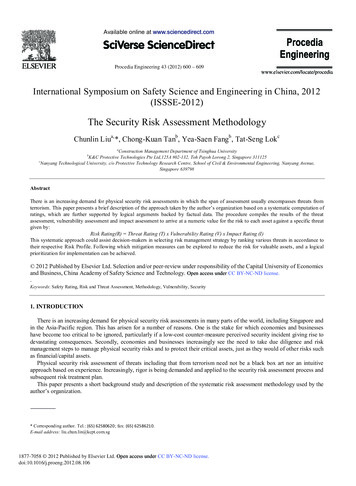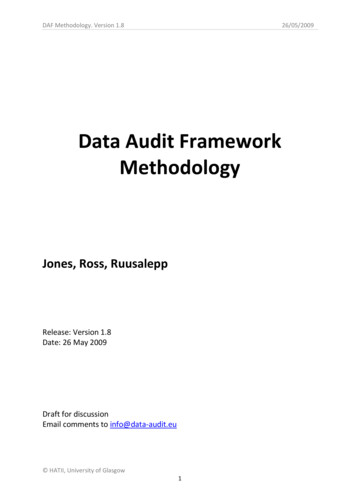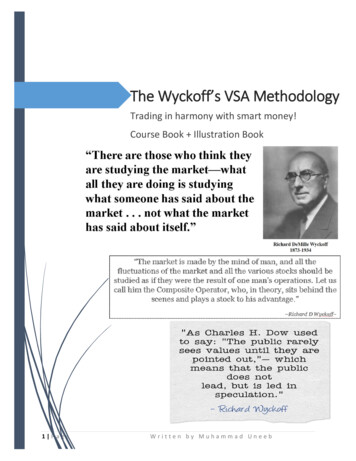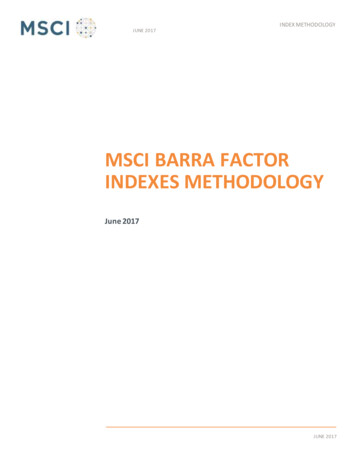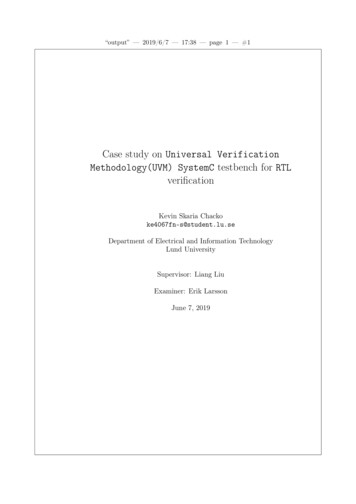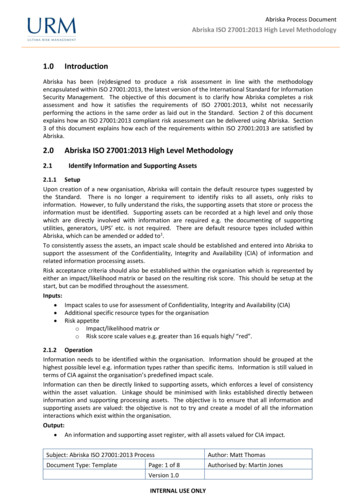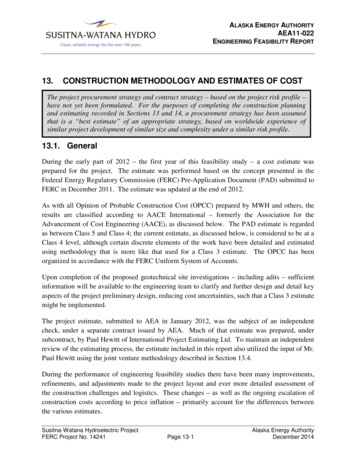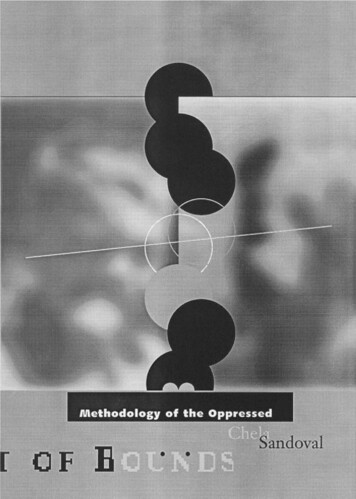
Transcription
Methodology of the Oppressed
Edited bySandra BuckleyMichael HardtBrian Massumi. . . UNCONTAINEDBY18Methodology of the Oppressed17Proust and Signs: The Complete Text16Deleuze: The Clamor of BeingChela SandovalGilles DeleuzeTHEAlain BadiouDISCIPLINES,15Insurgencies: Constituent Power andthe Modern StateAntonio Negri14When Pain StrikesKim Sawchuk, EditorsBill Burns, Cathy Busby, andINSUBORDINATE13Critical Environments: Postmodern Theory andthe Pragmatics of the “Outside”Cary Wolfe12Metamorphoses of the Body11The New SpinozaJosé GilP RACTICESOFR ESISTANCEWarren Montag and Ted Stolze, Editors.Inventing,10Power and Invention:Situating ScienceIsabelle Stengersexcessively,9Arrow of Chaos:Romanticism and Postmodernity8Becoming-WomanIra Livingstonin the between.Camilla Griggers7A Potential Politics:Radical Thought in ItalyP ROCESSESPaolo Virno and Michael Hardt, Editors6Capital Times:Tales from the Conquest of TimeÉric Alliez5The Year of PassagesRéda Bensmaïa4Labor of Dionysus:A Critique of the State-FormMichael Hardt and Antonio NegriOF3Bad Aboriginal Art: Tradition,Medi a, and Technol ogi cal H o r iz onsEric Michaels21The Cinematic BodyThe Coming CommunitySteven ShaviroGiorgio AgambenH YBRIDIZATION
Methodology of theOppressedChela SandovalForeword by Angela Y. DavisTheory out of BoundsVolume 18University of Minnesota PressMin n eap o lis L o n d o n
Shorter and different versions of chapter 2 were published as “U.S. Third World Feminism:The Theory and Method of Oppositional Consciousness in the Postmodern World,”Genders 10 (spring 1991), copyright 1991, reprinted by permission of the University of Texas Press;and as “Feminist Forms of Agency and Oppositional Consciousness,” inProvoking Agents: Gender and Agency in Theory and Practice, edited by Judith Kegan Gardiner(Chicago: University of Illinois Press, 1995), reprinted by permission of the University of Illinois Press.A different version of a section of chapter 5 was published as “Theorizing White Consciousness for aPost-Empire World: Barthes, Fanon, and the Rhetoric of Love,” in Displacing Whiteness:Essays in Social and Cultural Criticism, edited by Ruth Frankenberg(Durham: Duke University Press, 1997), 86–106; reprinted by permission of Duke University Press.Condensed, earlier versions of the second half of chapter 7 appeared as“New Sciences: Cyborg Feminism and the Methodology of the Oppressed,”The Cyborg Handbook, edited by Chris Hables Gray (New York: Routledge Press, 1995), 407–21,copyright 1995 from The Cyborg Handbook, reproduced by permission of Routledge, Inc.; and as“Re-Entering CyberSpace: Sciences of Resistance,” Dispositio/n: Journal of Cultural Histories and Theories 19,no. 46 (1994 [1996]): 75–93, published by the Department of Romance Languages and Literatures at theUniversity of Michigan, reprinted by permission of Dispositio/n.Copyright 2000 by the Regents of the University of MinnesotaAll rights reserved.No part of this publication may bereproduced, stored in a retrieval system,or transmitted,in any form or by any means,electronic, mechanical, photocopying,recording, or otherwise, withoutthe prior written permission of the publisher.Published by the University of Minnesota Press111 Third Avenue South, Suite 290Minneapolis, MN 55401-2520http://www.upress.umn.eduPrinted in the United States of America on acid-free paperLIBRARY OF CONGRESS CATALOGING-IN-PUBLICATION DATASandoval, Chela, 1956–Methodology of the oppressed / Chela Sandoval.p.cm. — (Theory out of bounds ; v. 18)Includes bibliographical references and index.ISBN 0-8166-2736-3 (alk. paper) — ISBN 0-8166-2737-1 (pbk. : alk. paper)1. Postmodernism — Social aspects. 2. Feminist theory. 3. Postcolonialism.4. Culture — Study and teaching. I. Title. II. Series.HM449 .S27 2000303.4 — dc2100-009294The University of Minnesotais an equal-opportunity educator and employer.11 10 09 08 07 06 05 04 03 02 01 0010 9 8 7 6 5 4 3 2 1
For Pearl Sandoval, my mother,whose courage and loveinspired this work.
This page intentionally left blank
We seek a world in which there is room for many worlds.Subcommander MarcosZapatista Army of Liberation (EZLN), Mexico
This page intentionally left blank
ContentsForewordAngela Y. DavisAcknowledgmentsI n tr o du c t i o nxixv1PART I.F ou nd a ti o ns i n Ne o c o lo n ial P o st mo d er n ismChapter 1.F re d ri c J a m e s o n: P os tmo d er n ism Is aNeocolonizing Global ForcePART II.15T he T he o ry a n d M e th od o f Op p o sit io n al Co n scio u sn essin the Postmodern WorldChapter 2.U.S. Third World Feminism: Differential Social Movement IPART III.The Methodology of the Oppressed: Semiotics,41Deconstruction, Meta-Ideologizing, Democratics,and Differential Movement IIChapter 3.On Cultural Studies: An Apartheid of Theoretical DomainsChapter 4.Semiotics and Languages of EmancipationChapter 5.The Rhetoric of Supremacism as Revealed by theEthical Technology: DemocraticsPART IV.Love in the Postmodern World:Di ffe r e n ti a l C o ns c i o u sn ess III1178167
Chapter 6.Love as a Hermeneutics of Social Change,a Decolonizing MovidaChapter 7.139Revolutionary Force: Connecting Desire to Reality159Conclusion: Differential Manifesto, Trans-Languages, andG l o ba l Op po s i ti on a l Po lit icsNotes185BibliographyIndex235211179
ForewordAngela Y. Davischela sandoval has always grappled with the dilemmas confronting scholars andactivists who work to make a difference in the world. With the publication of herpioneering essay “U.S. Third World Feminism: The Theory and Method of Oppositional Consciousness in the Postmodern World,” Sandoval emerged as an important thinker known for her rigorous critiques of feminisms that fail to acknowledgethe complicated ways race, class, and sex inform the category of gender. Sandovalargued for an emancipatory potential in women-of-color formations and strategiesprecisely because, unlike in neoliberal conceptions of diversity, difference could beembraced in these formations and strategies not as an objective in itself, but ratheras a point of departure and a method for transforming repressive and antidemocratic social circumstances.In placing U.S. third world feminism at the center of her work,Sandoval theorized a social movement in which she herself had played a major roleas organizer and theorist. As she revisited the work of Cherríe Moraga, Audre Lorde,Gloria Anzaldúa, Barbara Smith, Lorna Dee Cervantes, Paula Gunn Allen, BarbaraNoda, and many others, Sandoval engaged with texts that enacted the collaborativestrategies she also helped to shape. This legendary article, “U.S. Third World Feminism: The Theory and Method of Oppositional Consciousness in the PostmodernWorld,” developed Sandoval’s theory of differential consciousness, and revealed her
T H E O R Yability to directly confront some of the most vexing questions facing contemporarysocial activists.The groundwork for her analysis was set in a report she wroteon the 1981 National Women Studies Association Conference, where she examinedthe limitations of a women’s movement that “forced a false unity of women.” Differentially acting feminists of color, by virtue of their multiple positionalities, Sandovalargued, not only controverted the notion of a homogeneous (white) women’s movement, but they also could not harbor aspirations for a separate, unitary third worldwomen’s movement. In this formation Sandoval identified the potential for a “selfconscious flexibility of identity and political action,” and for the development ofcompetent critiques of the movement of power along axes of race, gender, class, andsexuality that could in turn serve as ingredients for a new methodology of liberation.In her new work, Methodology of the Oppressed, Sandoval designsa method for emancipation that builds bridges across theoretical chasms and createsstrategies for globalizing resistance from below. This book provides us with a seriesof methods, not only for analyzing texts, but for creating social movements andidentities that are capable of speaking to, against, and through power. Her theoryand method of oppositional consciousness in the postmodern world joins with the“methodology of the oppressed,” and together these methods create the mode ofsocial action, the hermeneutic she calls “love in the postmodern world.” Sandovalargues that this is the mode of social action and identity construction that is necessaryfor understanding ourselves, each other, and the nature of being and collectivity itself under economic and cultural globalization. Rooted in her knowledge of activism,Sandoval’s book is a map for understanding how to effect dissidence within twentyfirst-century cultural conditions.In Methodology of the Oppressed, Sandoval initiates a monumentaltask of resituating and reinterpreting the work of major Western theorists such asFredric Jameson, Roland Barthes, Michel Foucault, Donna Haraway, and HaydenWhite in relation to the insights of those U.S. women-of-color feminisms that insiston international solidarity, and resistance to racism, class bias, and homophobia. Here,Sandoval identifies important ways in which critical and cultural theorists have workedunder the philosophical and political influences of subordinated communities in pursuit of liberation. Sandoval’s work is a decolonizing theoretical and political enterprise arguing that oppositional consciousness is not a lost utopian ideal, and thatwith a differential form of consciousness, derived from women-of-color feminismsand the alliance-building strategies they demand, it is possible to avoid culs-de-sacin theory and political practice. The utopian impulse that informs Methodology of the
xii,xiiiOppressed, and the obstinacy (in the Marcusean sense) of Sandoval’s new critical theory,lead her and the reader on a quest for new vocabularies that can help to decolonizethe imagination.Methodology of the Oppressed is concerned with creating a placefor significant interventions in the social world; it can be described as a prolegomenonthat critically examines the conditions and possibilities for contemporary radicalmovements in this era of global capitalism. Emerging scholars who want to linktheir work to pursuits for social justice will be inspired by the way Chela Sandovalrefuses to abandon her belief in the possibility of revolutionary resistance. As thisbook troubles traditional ways of thinking about social activism, it simultaneouslysubverts the idea of the social passivity of theory. By focusing on prospects for psychicemancipation, Sandoval summons a new subject capable of love, hope, and transformative resistance.Foreword
This page intentionally left blank
AcknowledgmentsMETHODOLOGY OF THE OPPRESSED was born in the intellectual crucible that was the History of Consciousness program at the University of California at Santa Cruz. Mymentors there were Hayden White, Donna Haraway, James Clifford, and Teresa deLauretis. The book was also influenced by the many colleagues and friends I havebeen fortunate to know, especially Emma Pérez, Elizabeth Marchant, Caren Kaplan,Katie King, Zoe Soufoulis, Sandra Azaredo, Ronaldo Balderrama, Antonia Casteñeda,Aida Hurtado, Norma Alarcón, José Saldívar, Lisa Lowe, Bettina Aptheker, MargeFranz, Nancy Stoller-Shaw, Catherine Angel, and Helene Moglan. Friendship, ongoing conversations, published and unpublished exchanges over the years with admired allies and colleagues Gloria Anzaldúa, Angela Davis, Noel Sturgeon, Tim Reed,Gayatri Spivak, Fredric Jameson, Vivian Sobchack, Constance Penley, Barbara Ige,Shirley Flores-Muñoz, Yolanda Broyles-Gonzalez, Audre Lorde, Roz Spafford, MargeFranz, James “the Computer Wiz,” Ellie Hernandez, Charles Long, Osa Hidalgo,Stephen Heath, and Michel Foucault everywhere inform these chapters.Methodology of the Oppressed was completed with the support ofthe University of California Humanities Research Institute located on the SantaBarbara campus. I am especially grateful to Rafael Pérez-Torres, Lata Mani, RuthFrankenberg, and Katie King, who, aside from having read parts of the manuscriptin process, have been critically astute, supportive, and generous colleagues and friends.
O U TT H E O R YI greatly appreciate my students in the Chicano Studies Department at Santa Barbara,whose participation and engagement advanced and grounded this book in unexpectedways. Methodology of the Oppressed would not have been completed without the devotedhelp of Lisa Biddle and Janet Sandoval. Lisa generated the graphics, illustrations, andhelped me copyedit the book. My sister Janet contributed expert organizational andeditorial advice above and beyond the call of duty. Heartfelt thanks go to the spiritual activists who provided encouragement, support, and affection during the book’scompletion, especially Nancy Giulliani. Finally, I want to acknowledge those dearfriends whose love, generosity, and friendship have sustained me: Billie Harris, JimVieth, Pam Springer, Tish Sainz, Susana Montaña, Michael Angelo Nocera, andRosa Villafañe-Sisolak and her children (my stepchildren) Almanda, Jason, Ariel,Adam, Nina, and Aaron.Methodology of the Oppressed is lovingly dedicated to Pearl AntoniaDoria-Sandoval and José Machlavio Lucero-Sandoval, my philosopher mother andsocial activist father; to my sisters Janet, Robin, Sandy, and Julie; and to our aunts,uncles, and primos/as — the Luceros, Serranos, Sandovals, Archluletas, Naranjas, andDorias in honor of the new pasts and futures we are weaving.
I n tro d u c t i onWhere there is power there is resistance.Michel FoucaultThe range of contemporary critical theories suggests that it is from those who havesuffered the sentence of history — subjugation, domination, diaspora, displacement — thatwe learn our most enduring lessons for living and thinking.Homi BhabhaGive name to the nameless so it can be thought.Audre Lordemanifest landmarks in theory transfigure when the foundational underplatethat makes
14 When Pain Strikes Bill Burns, Cathy Busby, and Kim Sawchuk, Editors 13 Critical Environments: Postmodern Theory and the Pragmatics of the “Outside” Cary Wolfe 12

